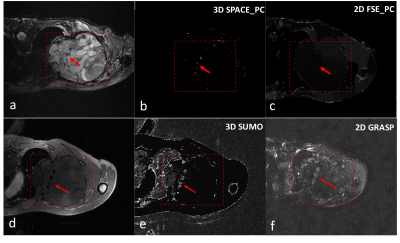Caiyun Shi1,2, Dong Liang1,2,3, Zhilang Qiu1, Xin Liu1,2, Yanjie Zhu1,2, and Haifeng Wang1,2
1Shenzhen Institutes of Advanced Technology, Chinese Academy of Sciences, Shenzhen, China, 2Shenzhen College of Advanced Technology, University of Chinese Academy of Sciences, Shenzhen, China, 3Research Centre for Medical AI, Shenzhen Institutes of Advanced Technology, Chinese Academy of Science, Shenzhen, China
1Shenzhen Institutes of Advanced Technology, Chinese Academy of Sciences, Shenzhen, China, 2Shenzhen College of Advanced Technology, University of Chinese Academy of Sciences, Shenzhen, China, 3Research Centre for Medical AI, Shenzhen Institutes of Advanced Technology, Chinese Academy of Science, Shenzhen, China
Susceptibility-based positive contrast MR imaging exhibits excellent
efficacy for visualizing the MR compatible metallic devices. In this work, a novel method
is developed to realize the 3D susceptibility-based positive contrast MR
imaging on in vivo human patient.

Figure 1.(a) Diagram of
the modified 3D SPACE sequence. Compared to the conventional SPACE sequence,
each readout in the modified SPACE
sequence is shifted by a short time Tshift. The nature of the SPACE
sequence helps to reduce the rapid signal dephasing and phase wrapping due to
the high susceptibility of the metallic devices. By processing two sets of
imaging data (with and without Tshift), the local field map (phase
change) induced by the susceptibility of interventional devices can be
calculated. (b) Variable-flip-angle of the 3D SPACE with refocusing pulse.

Figure 5.Representative results of the in vivo experiments of
a human patient with one tumour of the scapula. (a) Magnitude
images generated by the proposed method; (b~c) The positive contrast images
generated by the proposed 3D SPACE-based method, 2D FSE based sequence; (d)
Magnitude images generated by the SUMO, susceptibility gradient mapping using
the original resolution; (e~f) The positive contrast images generated by the 3D
SUMO, 2D GRASP (gradient echo acquisition for super-paramagnetic particles).